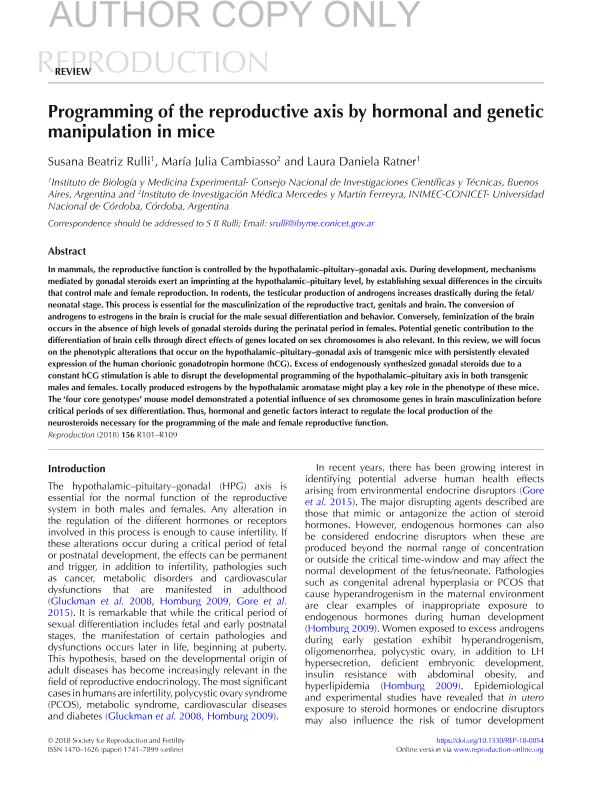Mostrar el registro sencillo del ítem
dc.contributor.author
Rulli, Susana Beatriz

dc.contributor.author
Cambiasso, Maria Julia

dc.contributor.author
Ratner, Laura Daniela

dc.date.available
2019-11-30T22:48:04Z
dc.date.issued
2018-06
dc.identifier.citation
Rulli, Susana Beatriz; Cambiasso, Maria Julia; Ratner, Laura Daniela; Programming of the reproductive axis by hormonal and genetic manipulation in mice; BioScientifica; Reproduction; 156; 4; 6-2018; R101-R109
dc.identifier.issn
1470-1626
dc.identifier.uri
http://hdl.handle.net/11336/91062
dc.description.abstract
In mammals, the reproductive function is controlled by the hypothalamic-pituitary-gonadal axis. During development, mechanisms mediated by gonadal steroids exert an imprinting at the hypothalamic-pituitary level, by establishing sexual differences in the circuits that control male and female reproduction. In rodents, the testicular production of androgens increases drastically during the fetal/neonatal stage. This process is essential for the masculinization of the reproductive tract, genitals and brain. The conversion of androgens to estrogens in the brain is crucial for the male sexual differentiation and behavior. Conversely, feminization of the brain occurs in the absence of high levels of gonadal steroids during the perinatal period in females. Potential genetic contribution to the differentiation of brain cells through direct effects of genes located on sex chromosomes is also relevant. In this review, we will focus on the phenotypic alterations that occur on the hypothalamic-pituitary-gonadal axis of transgenic mice with persistently elevated expression of the human chorionic gonadotropin hormone (hCG). Excess of endogenously synthesized gonadal steroids due to a constant hCG stimulation is able to disrupt the developmental programming of the hypothalamic-pituitary axis in both transgenic males and females. Locally produced estrogens by the hypothalamic aromatase might play a key role in the phenotype of these mice. The 'four core genotypes' mouse model demonstrated a potential influence of sex chromosome genes in brain masculinization before critical periods of sex differentiation. Thus, hormonal and genetic factors interact to regulate the local production of the neurosteroids necessary for the programming of the male and female reproductive function.
dc.format
application/pdf
dc.language.iso
eng
dc.publisher
BioScientifica

dc.rights
info:eu-repo/semantics/openAccess
dc.rights.uri
https://creativecommons.org/licenses/by-nc-sa/2.5/ar/
dc.subject
hCG
dc.subject
ESTRADIOL
dc.subject
HYPOTHALAMUS
dc.subject
SEX CHROMOSOMES
dc.subject.classification
Biología del Desarrollo

dc.subject.classification
Ciencias Biológicas

dc.subject.classification
CIENCIAS NATURALES Y EXACTAS

dc.title
Programming of the reproductive axis by hormonal and genetic manipulation in mice
dc.type
info:eu-repo/semantics/article
dc.type
info:ar-repo/semantics/artículo
dc.type
info:eu-repo/semantics/publishedVersion
dc.date.updated
2019-10-17T15:43:59Z
dc.journal.volume
156
dc.journal.number
4
dc.journal.pagination
R101-R109
dc.journal.pais
Reino Unido

dc.journal.ciudad
Bristol
dc.description.fil
Fil: Rulli, Susana Beatriz. Consejo Nacional de Investigaciones Científicas y Técnicas. Instituto de Biología y Medicina Experimental. Fundación de Instituto de Biología y Medicina Experimental. Instituto de Biología y Medicina Experimental; Argentina
dc.description.fil
Fil: Cambiasso, Maria Julia. Consejo Nacional de Investigaciones Científicas y Técnicas. Centro Científico Tecnológico Conicet - Córdoba. Instituto de Investigación Médica Mercedes y Martín Ferreyra. Universidad Nacional de Córdoba. Instituto de Investigación Médica Mercedes y Martín Ferreyra; Argentina
dc.description.fil
Fil: Ratner, Laura Daniela. Consejo Nacional de Investigaciones Científicas y Técnicas. Instituto de Biología y Medicina Experimental. Fundación de Instituto de Biología y Medicina Experimental. Instituto de Biología y Medicina Experimental; Argentina
dc.journal.title
Reproduction

dc.relation.alternativeid
info:eu-repo/semantics/altIdentifier/url/http://www.reproduction-online.org/lookup/doi/10.1530/REP-18-0054
dc.relation.alternativeid
info:eu-repo/semantics/altIdentifier/doi/http://dx.doi.org/10.1530/REP-18-0054
Archivos asociados
